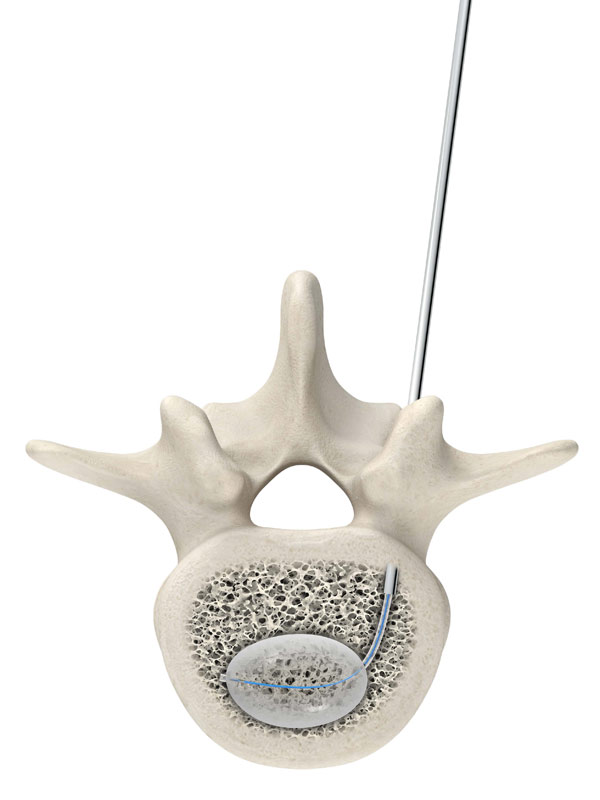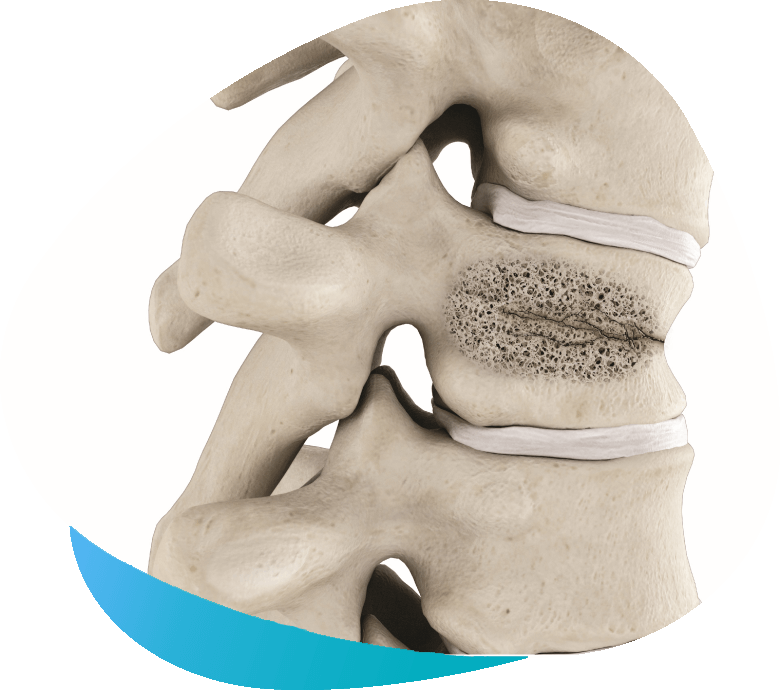Vertebral Compression Fracture
A vertebral compression fracture occurs when a bone in the spine collapses. Vertebral bodies are the bones in your spine that bear the weight of your body. These fractures usually happen in the thoracic spine (the middle portion of the spine), most common in the lower vertebrae of the thoracic spine or in the lumbar spine (lower back). These fractures can lead to an incapacitating back pain and a reduction in your mobility.
Causes of a Vertebral Compression Fracture
Compression fractures of the spine often occur when there is too much pressure on the vertebral body in the case of an accident or if the bone matrix is weak. This can result from a combination of bending forward and downward pressure on the spine.
Osteoporosis increases the risk of compression fractures. Osteoporosis tends to thin the bones, sometimes to the point that they are too weak to bear normal weight or pressure. Thinning bones can collapse during normal activity, leading to a spinal compression fracture and severe pain.

Severe cases of osteoporosis may cause a disorder called kyphosis or “dowager’s hump”. This exaggeration of your spine causes the shoulders to slump forward and the top of the back to look enlarged or humped. It can also cause people to get shorter over time.
Trauma to the spinal vertebrae may also lead to minor to severe fractures. Examples of causes could be a fall, a jump, a car accident, or any other event that over stresses the spine.
Metastatic disease or cancer is another cause of vertebral fractures. Metastasis refers to the spread of cancer cells into other parts of the body. The bones of the spine are a common place for many types of cancers to spread.
An unexpected appearance of a compression fracture of the spine without obvious trauma may be the first indication that of an unrecognized cancer that has spread to the spine. The destruction that cancer causes to part of the vertebra may weaken the bone until it collapses. This is a sign that something going on internally is harming the bones.
Treatments for Vertebral Compression Fractures
Vertebral compression fractures are very painful and should be addressed promptly with our Albuquerque compression fracture treatments. If not addressed quickly, the fracture can worsen and severely decrease the height of the vertebral body. If there is too much vertebral body height loss, it can result in pinching of nerves, severe kyphosis or bending forward, significant facet (joints of the back), and muscle pain.
If the vertebral body is amenable to augmentation, it is usually advisable to proceed with treating the fracture to stabilize it and stop further collapse. Augmentation means to add to. In the case of our Albuquerque compression fracture treatments, cement, or polymethylmethacrylate, is injected into the fractured bone to heal the fracture and stabilize it.
During the vertebral augmentation procedure, the patient is placed on their stomach on a procedure table usually in an outpatient clinic or a surgical center. Under x-ray guidance, 1 or 2 cannulas (large needles) are precisely guided into the fractured vertebral body. This is followed by insertion of a small balloon through the needle. The balloon is then inflated inside the vertebral body which sometimes leads to some restoration of the vertebral body height. The balloons are then deflated and removed followed by administration of a cement material, called polymethylmethacrylate, which is of a toothpaste consistency. The cement hardens and cures within 15-20 minutes resulting in a stabilization of the fracture. There is some heat involved in the chemical reaction of the cement that allows it to harden so quickly. An added benefit of this heat is that it can denature the nerves that are sending the pain signal and give immediate pain relief. There is also often an immediate relief of pain once our Albuquerque kyphoplasty treatment is done and the cement hardens, as the fracture is not doing micromovements any longer.
Some vertebral bodies are not able to undergo the vertebral augmentation. If they are too compressed or too unstable then it is sometimes safer to treat with bracing and medication. If the fracture communicates with the spinal canal and there is any bony material pressing into the canal, this procedure is often not performed. A thorough evaluation of your imaging and your symptoms prior to proceeding is important.
Medications
There are several medications that can be used to help strengthen weak bones. The bone matrix is a dynamic system that involves constant remodeling. There are cells that lay down new bone and cells that break down old bone. Some medications stimulate the cells that lay down new bone and other medications decrease the activity of the cells that break down old bone. Often a consult to a primary care or endocrinology is useful to decrease the likelihood of another fracture happening. Supplements such as calcium and magnesium are also important and should be optimized.
Bracing
Bracing is also an important temporary step in our Albuquerque compression fracture treatments, it can decrease the pressure on the vertebral body and give it time to heal.



